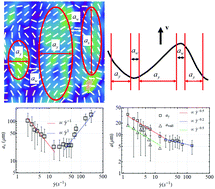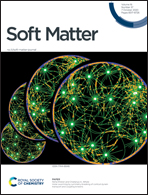Shear-induced polydomain structures of nematic lyotropic chromonic liquid crystal disodium cromoglycate†
Abstract
Lyotropic chromonic liquid crystals (LCLCs) represent aqueous dispersions of organic disk-like molecules that form cylindrical aggregates. Despite the growing interest in these materials, their flow behavior is poorly understood. Here, we explore the effect of shear on dynamic structures of the nematic LCLC, formed by 14 wt% water dispersion of disodium cromoglycate (DSCG). We employ in situ polarizing optical microscopy (POM) and small-angle and wide-angle X-ray scattering (SAXS/WAXS) to obtain independent and complementary information on the director structures over a wide range of shear rates. The DSCG nematic shows a shear-thinning behavior with two shear-thinning regions (Region I at ![[small gamma, Greek, dot above]](https://www.rsc.org/images/entities/i_char_e0a2.gif) < 1 s−1 and Region III at
< 1 s−1 and Region III at ![[small gamma, Greek, dot above]](https://www.rsc.org/images/entities/i_char_e0a2.gif) > 10 s−1) separated by a pseudo-Newtonian Region II (1 s−1 <
> 10 s−1) separated by a pseudo-Newtonian Region II (1 s−1 < ![[small gamma, Greek, dot above]](https://www.rsc.org/images/entities/i_char_e0a2.gif) < 10 s−1). The material is of a tumbling type. In Region I,
< 10 s−1). The material is of a tumbling type. In Region I, ![[small gamma, Greek, dot above]](https://www.rsc.org/images/entities/i_char_e0a2.gif) < 1 s−1, the director realigns along the vorticity axis. An increase of
< 1 s−1, the director realigns along the vorticity axis. An increase of ![[small gamma, Greek, dot above]](https://www.rsc.org/images/entities/i_char_e0a2.gif) above 1 s−1 triggers nucleation of disclination loops. The disclinations introduce patches of the director that deviates from the vorticity direction and form a polydomain texture. Extension of the domains along the flow and along the vorticity direction decreases with the increase of the shear rate to 10 s−1. Above 10 s−1, the domains begin to elongate along the flow. At
above 1 s−1 triggers nucleation of disclination loops. The disclinations introduce patches of the director that deviates from the vorticity direction and form a polydomain texture. Extension of the domains along the flow and along the vorticity direction decreases with the increase of the shear rate to 10 s−1. Above 10 s−1, the domains begin to elongate along the flow. At ![[small gamma, Greek, dot above]](https://www.rsc.org/images/entities/i_char_e0a2.gif) > 100 s−1, the texture evolves into periodic stripes in which the director is predominantly along the flow with left and right tilts. The period of stripes decreases with an increase of
> 100 s−1, the texture evolves into periodic stripes in which the director is predominantly along the flow with left and right tilts. The period of stripes decreases with an increase of ![[small gamma, Greek, dot above]](https://www.rsc.org/images/entities/i_char_e0a2.gif) . The shear-induced transformations are explained by the balance of the elastic and viscous energies. In particular, nucleation of disclinations is associated with an increase of the elastic energy at the walls separating nonsingular domains with different director tilts. The uncovered shear-induced structural effects would be of importance in the further development of LCLC applications.
. The shear-induced transformations are explained by the balance of the elastic and viscous energies. In particular, nucleation of disclinations is associated with an increase of the elastic energy at the walls separating nonsingular domains with different director tilts. The uncovered shear-induced structural effects would be of importance in the further development of LCLC applications.



 Please wait while we load your content...
Please wait while we load your content...